
The deserts of Asia and Australia: legendary!
Inhabitants of the deserts of Asia
The sandy desert of the Arabian Peninsula is steadily swept by a blazing hot dry wind that comes from Central Asia. The Gobi is a cold and rocky desert that spreads through southern Mongolia and northern China. Here, there can be as much as an 80°C difference between winter and summer temperatures, with the thermometer rising from –40°C to over 40°C ! The Thar Desert, covered in reddish sand dunes, is Asia’s easternmost hot desert. The deserts of Asia are inhabited by animals such as scorpions, hard-shelled insects and camels, some of which are still living in the wild.
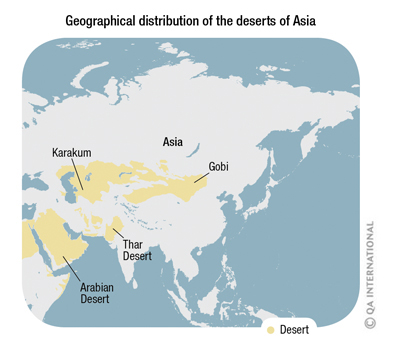
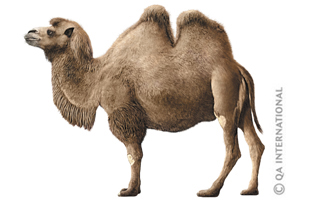
The Bactrian camel
The Bactrian camel lives in the mountainous regions of the Gobi Desert. After long intervals without drinking, this mammal can quickly swallow more than 100 liters of water! It stores the water in the fatty tissue of its humps in anticipation of a shortage. There are currently fewer than 1,000 Bactrian camels living in the wild (most of them have been domesticated). They are in critical danger of becoming extinct, notably because of attacks by wolves, but also because of humans, who hunt them for their meat.

The small beetle
The small darkling beetle is perfectly equipped to withstand the rough climate of the deserts of North Africa and the Middle East. It has a portable humidifier concealed beneath its hindquarters. It is in fact a small chamber that cools and humidifies the air before it enters the body of the insect, preventing it from becoming dehydrated.

The scorpion
Scorpions have colonized every continent (except Antarctica) and have adapted to numerous habitats. They are, however, mainly found in hot, arid regions. The 2,000 or so species of scorpions can be distinguished from their relatives, the spiders, by their pincers and the venomous stinger at the tip of their abdomen. Their venom is generally not dangerous to humans. Scorpions use it to defend themselves and to immobilize their prey, which includes spiders and insects.
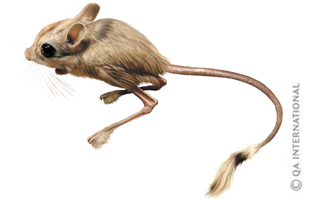
The desert jerboa
The jerboa springs away at high speed when fleeing predators. Equipped with hind legs that are four times longer than their forelegs, these small sand-dwelling mammals can jump distances of 3 m and reach a speed of 25 km/h. In the deserts of northern Africa, Arabia and Central Asia, jerboas dig deep burrows where they hide during the day, sheltered from the heat.
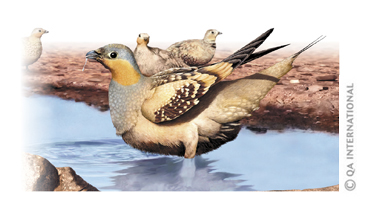
The spotted sandgrouse
Spotted sandgrouses can travel tens of kilometers each day, flying in a flock as they search for water in the desert expanses of India, the Middle East and the Sahara. Squatting in the small pools they find, the males try to store as many water droplets as possible in the special feathers on their abdomen, which act like sponges. Once they are thoroughly drenched, the sandgrouses return to the nest to shower their chicks.
Inhabitants of the deserts of Australia
Deserts cover almost half of Australia. They are mainly confined to the central and western parts of the country. The deserts of Australia account for more than 10 percent of the world’s entire desert land surface! A few plants grow in these vast expanses of pebbles and reddish sand: acacias, cypress pines, desert peas that produce magnificent red flowers and clumps of prickly graminates. The Australian deserts are also home to a wide variety of animals, including venomous snakes, monstrous lizards, toads that bury themselves in the ground to wait for rain and some dromedaries that have returned to the wild.
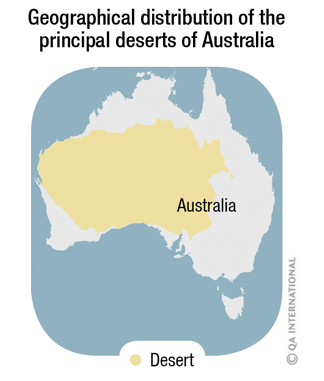
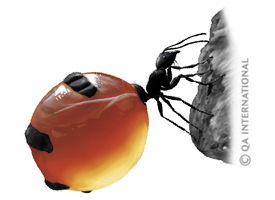
The honeypot ant
The honeypot ant lives in the arid regions of Australia, Africa and North America. Certain individuals in a colony, the repletes, are overfed honeydew and plant sap by their fellow workers. They live suspended in tunnels, their expandable stomach growing to the size of a pea, and will regurgitate their delicious supply of sugary liquid to nourish the colony during long periods of drought. The aboriginal people of Australia consider honeypot ants a tasty dish.
The bearded dragon
The bearded dragon of Australia is a lizard that prefers to live in arid zones in the central and eastern parts of the country. When threatened, it stands on its hind legs and runs away through the blazing hot sand dunes. This ingenious way of running also allows the lizard to cool its body when the air is suffocating. This small, docile diurnal reptile used to be captured by humans to be a pet. Australia now formally prohibits the trade.

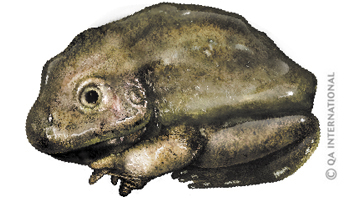
The water-holding frog
Buried 1 m deep in the arid Australian earth, the water-holding frog dozes as it waits for the next rains... sometimes for several years! This amphibian has two layers of skin, between which it stores water absorbed by its pores during the rare rains—a vital reserve when the frog is sleeping during periods of drought.
The thorny devil
The thorny devil, also called the moloch, is definitely not a mouthwatering meal for the other animals of the Australian desert. This lizard is in fact covered in thorny spines. Besides intimidating its adversaries, the spines on its body serve to channel water from dew and the rare rains. Small grooves carry the water that is collected directly into its mouth.

The dromedaries set free
The dromedaries living in Australia were imported from Africa and Asia in the 19th century by European explorers. The animals were used to transport goods in the arid zones of the country’s interior. Once their task was completed, the pioneers set these large mammals free. Adapting well to Australia’s arid climate, the dromedaries increased their numbers, so much that today there are several hundred thousand living in the wild. They are too numerous, having taken over certain regions in Australia, and so they are now being sold in other countries.
Also see:
In the Visual Dictionary: "vegetable kingdom", "animal kingdom" and "Earth" sections
In the encyclopedic capsules:
- Deserts: where Mother Nature is queen
- The deserts of the Americas and Africa
- The fauna and flora of polar regions: Arctic
- The fauna and flora of polar regions: Antarctic
- The spider, a web master
- Marsupials
- Mountains: the top of the world
In the ikonet games:
- Put it in its place!: deserts, land pollution, examples of reptiles




